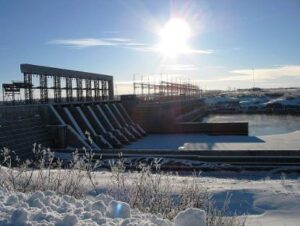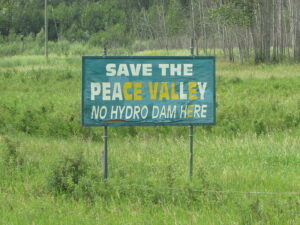As ongoing global reliance on fossil fuels continues to accelerate climate change, urgency and interest in transitioning to renewable energy sources is increasing. A 2019 survey from the Pew Research Center found that most Americans believe the United States should prioritize expanding renewable energy sources over the continued use of fossil fuels.
Within the energy sphere, hydropower is listed as a renewable energy alongside wind, solar, and geothermal. It is often framed as a source of naturally replenishing “clean energy”, less harmful to humans and ecosystems than fossil fuels. However, upon closer investigation, the picture of hydropower becomes murky, particularly when impacts on the local ecosystem and communities are considered.
Threats to Free-Flowing Rivers
Although hydropower dams are perceived as an environmentally friendly alternative to fossil fuels, dams drastically alter rivers, reducing ecosystem services relied upon by both riverine species and nearby human communities.
Rivers are already under pressure from changing temperatures, precipitation patterns, storm severity, and subsequent impacts on water quality, biodiversity, and habitat. At present, only 37% of the world’s longest rivers remain free flowing, and out of the world’s 91 rivers over 1,000KM originally flowing to the ocean, only 21 remain connected to the sea.
As humans continue to turn to hydroelectric power as an alternative energy source, 3,700 new hydropower dams are either planned or under construction, adding to the estimated 60,000 large dams currently in existence across the globe.
Constructing dams on rivers also threatens freshwater species, as dams block natural pathways between fish feeding and spawning grounds, limiting reproduction. The 2018 Living Planet Report from the World Wildlife Foundation noted an 83% decline in freshwater biodiversity between 1970 and 2014, identifying dams and other water infrastructure as primary drivers of this significant reduction in biodiversity.
Furthermore, dams are being constructed in protected areas, including those already vulnerable to biodiversity loss. Rivers, the creatures that inhabit them, and the communities that depend upon them in the US and across the world are being sacrificed in the name of a hydropower.
Dam(n) Greenhouse Gasses

Despite consistent rhetoric around dams being a renewable energy source and an environmentally responsible alternative to fossil fuels, hydropower has been found to cause significant disruptions to the natural carbon cycle.
Human constructed dam reservoirs trap almost one-fifth of organic carbon moving from riverine to oceanic environments. With 90% of rivers world wide predicted to host at least one dam in the next 15 years, impacts on the natural carbon cycle will continue to intensify over time. As the building block of life, the carbon cycle is the basis for primary productivity, and reductions in carbon moving through an ecosystem can have significant detrimental effects on its stability and productivity.
Furthermore, the reservoirs created by dams emit methane. A study using bubble-tracking sonar found that each square meter of reservoir surface emitted 25% more methane than previous estimates suggested. Despite considerable emissions, methane from dams is not currently calculated into global or United States greenhouse gas inventories.
When under consideration as a renewable energy, the carbon and methane associated with dams must be included in all cost benefit analyses, along with impacts to local biological and human communities.
Colonialism and Social Justice
The construction of dams both in modern and historical moments has resulted in the relocation of communities, causing disruption of livelihoods, cultural and social resources, space, and property. During the second half of the twentieth century, millions of indigenous people across the global south were displaced to build large-scale hydroelectric reservoirs.
And not only are communities living in the basin of any new dam reservoir displaced, those living downstream who rely on riverine resources are secondarily displaced by losing income sources. In addition to indigenous populations, the people displaced globally by hydroelectric projects are often the most vulnerable and those with the least wealth.
A 2016 article published in the Indiana Journal of Global Legal Studies categorized eight specific displacement risks for indigenous populations: landlessness, joblessness, homelessness, marginalization, food insecurity, increased morbidity, lost access to common resources, and community dislodgement.
Harm to Indigenous Communities

In Canada, colonial displacement of indigenous people laid the groundwork for hydropower development. According to the Northeast Mega Dam Resistance Coalition, the Canadian government built the 7,722 MW Bourassa Dam in Eastern Canada without informing or consulting local indigenous populations, draining and diverting 32,400 square miles of forests, wetlands and rivers.
And the Canadian government and hydropower developers continue to unrelentingly pursue damming rivers on indigenous lands, going so far as to intimidate local communities to flood 16,000 square miles of the Rupert, Broadbeck and Nottaway Rivers to expand the capacity of the La Grande River hydroelectric generation.
Canadian indigenous communities have time and time again spoken out against environmental injustices experienced by frontline communities, as well as continued destruction of critical components of both indigenous identity and life, including, subsistence resources, land, and grave sites.
And we in the U.S. are implicated, too. Pressure for further hydroelectric development on indigenous land in Canada stems from increasing interest from the United States for imported hydropower from our neighbor to the north.
Moving Forward With or Without Hydroelectric
An emerging non-conventional approach to hydroelectric power is incorporating hydroelectric generation into existing water and wastewater systems. A 2011 Report by NYSERDA found that the 2,600 wastewater treatment plants in the United States are suitable for hydroelectric generation, and when turbines are incorporated into drinking water infrastructure, the potential capacity is even greater.
Although a timely transition to renewable energy is inevitable if irreversible climate change is to be avoided, harm for human and biological communities is not inevitable. Looking beyond hydropower, a 2019 study titled Connected and Flowing: A Renewable Future for Rivers, Climate, and People found global utilization of low-impact wind and solar power on existing rooftops and degraded lands would provide 17 times the renewable energy targets in the Paris Climate Agreement.
As a global society, we have a choice to make: to sacrifice indigenous and marginalized communities and ecosystems, or to center indigenous and marginalized communities and prioritize biological diversity and free flowing waterways.
It is my hope we will select the latter.
